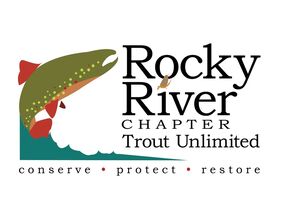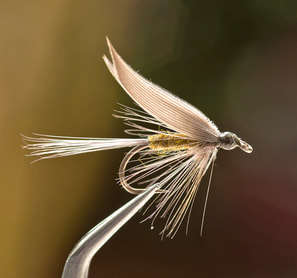Fly of the Month
We continue with Part Two of Blue Wing Olive (BWO). Our general research indicates that the nymph stage of the BWO is very important during the winter months. BWOs uniquely hatch on any given day that is cloudy, overcast, drizzly or even during intermittent rain, especially early in the morning and later in the afternoon. In addition to trout feeding heavily on nymphs, Part Two will address two other BWO situations occurring underwater, emergers just below the surface and submerging female egg-laying adults making sure their eggs are attached to the bottom structures.
Blue Wing Olive – Part Two – NymphsRecall “Pheasant Tail Nymphs or a Gold-Ribbed Hares Ear work as imitations of the BWO. (You should) dead-drift the fly in the water just downstream from a riffle. Which brings us back to positively rheotactic which, rather than an exclamation, is a term used by entomologists to describe how riffle species generally orient head first into the current.” says Tim Wilhelm in his article in October 2011. Since BWO nymphs are bottom crawlers, a bead head, olive version of the pheasant tail or hares ear may be more effective for general use or a Bead Head Baetis Nymph (which is olive) is a much closer imitation for getting down to specifically determining if the trout are truly bottom feeding on BWO nymphs. If the trout appear to be “bulging” which is feeding just under the surface without actually rising, a BWO emerger may be the very fly pattern required. If this does not work, try the fly patterns covered in Part One (refer to Fly of the Month 3.15).Recall “…the egg-laying female crawls below the surface to lay eggs and are often knocked loose. When nothing else appears to be working (you should) try a soft hackle (or wet fly which) works well here. Put a small shot on the leader and cast upstream, giving the fly time to reach the bottom. Then jig the rod to give the fly some action.” says Tim Wilhelm in his article in October 2011. The key here is to leverage the current in the riffle. Position yourself to one side and upstream of the riffle and fly fish downstream with a soft hackle or wet fly. The trout sense no leader as they can only see what appears to be a female BWO maneuvering in the current to get to a rock to lay eggs. Fool’em with the natural action of the riffle current in their face!
We provide three (4) recipes for below surface fly presentations of the Blue Wing Olive.
Flies of the Month 3.15
BWO Nymph (refer to Fly of the Month 10.11)
Bead Head Baetis Nymph
BWO CDC Emerger (refer to Fly of the Month 10.11)
BWO Para Emerger
Center-Beaded Partridge and Olive Soft Hackle (with egg sac)
Olive Dun Wet Fly (Bergman, Ray. Trout, Plate No. 6, recipe on page 485)
- Tom Adams, Alen Baker
BWO Wet Fly
HOOK : Wet Fly Tiemco 3769 or equivalent, size 8,10,12,14
Thread : 8/0 Uni or equivalent in olive
Tail : Medium dun spade hackle
Body : BWO dubbing
Wing : Duck Quill, matching pair
Hackle : Medium dun hen
Directions :
- Debarb the hook and mount in the vise. Tie in an eyelength back from the eye and advance thread in tight, touching turns to the hook bend. Let the bobbin hang.
- Select a dozen or so spade hackle feathers and align the tips. Pull away from the feather shaft while holding the tip to maintain alignment. Tie in with a soft wrap on top of the hook shank to be slightly more than the shank length. Once the length is good, complete the wraps in touching turns, which gain in firmness as you advance covering the hackle. Keep the hackle on top of the shank and return the thread to above the hook barb. Let the bobbin hang.
- Dub the thread to form a two inch noodle of BWO dubbing and begin wrapping forward to the eye in touching, even slightly overlapping turns, to the thorax (about a third of the shank length from the eye. It may take one or two more additions of dub to build a body, which has a taper toward the eye. Let the bobbin hang.
- Select a dun hen feather, which is size appropriate, and strip away the webby barbs by pulling away with your fingers. Tie the hackle in by the exposed tip, with the “shiny” side toward you, and trim away any waste. Tie in close to the dub. Let the bobbin hang.
- Wrap the hackle in touching turns, gently stroking back the barbs as you wrap, to avoid bunching, for two or three turns. Tie off and trim away the waste and let the bobbin hang. There should be sufficient room for the wings and a nice head without crowding the eye.
- Select a matching pair of duck quills and cut or tear, a quarter inch, matching section from each quill. Align the tips of the duck so that they turn away from each other and the diagonal slope of the tips is a downward slope. Keeping them aligned with a pinch of your left hand, position on top of the hook shank, directly above the thread (tie in point). Make a soft wrap of thread and then pull up and straight to trap the quills on top of the hook. The quills are still held with by your left hand to maintain position on the hook. Make another two or three turns to bind in the quills. They should remain parallel throughout the process. This is by far the most challenging aspect, and it may take several attempts. This is such a useful and beautiful technique, do not lose heart and keep trying until successful. Trim away waste and form a substantial thread head. Whip finish and apply two coats of head cement.

